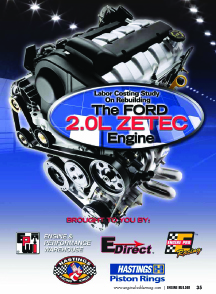
If a name works, why not stick with it? That’s pretty much the attitude that Ford has taken with regard to its popular inline four-cylinder engine named Zetec.
The Zetec name can be used to describe many different multi-valve DOHC engines, based on three distinctly different designs. It was used in several Ford, Mercury and Mazda cars, such as the Mondeo, the 1995-2000 Cougar/Mystique; the 1999-2002 Cougar; 2000-2003 Escape/Tribute; 2000-2003 Focus and 1998-2003 Escort ZX2. It was built in 1.25L, 1.4L, 1.6L, 1.7L, 1.8L, 2.0L and 2.3L displacements.
Truly a world engine, the Zetec was used in Europe (engines built in Bridgend, Wales and Valencia, Spain), North America (built in Chihuahua, Chihuahua, Mexico), Asia (built in Chung Li, Taiwan), South America (built in Sao Paulo, Brazil); and some in Inonu, Turkey.
Confusing? Possibly, but for this discussion, we will look at the popular 2.0L Zetec that had a 3.339? (84.8 mm) bore and 3.465? (88 mm) stroke that it shared with its predecessor, the 2.0L 2-valve CVH.
The SVT version provided much higher output thanks to its 10.2:1 compression ratio and larger valves.
A variety of issues were present with this engine over the years, say experts, including persistent valve tapping if a certain Ford oil wasn’t used. Still, this was a popular engine that you’re likely to see now in your shop.
In this section, you’ll find our current labor costing study on rebuilding the Ford 2.0L Zetec engine, which offers a look at national and regional average labor charges. The study covers various head, block and crankshaft service procedures as well as miscellaneous labor charges.
The charts begin on page 40. In addition, the detailed chart on page 38 represents the national average, median and mode labor charges for all of the procedures covered in our survey.
Your operational procedures may allow you to be more productive than these charts indicate. Conversely, you may find your costs are significantly higher than others in your same area. These discrepancies should not be seen as indicating that your costs are either too high or too low.
According to Bob Roberts, Market Research Manager for Babcox Research, these discrepancies may be seen for several reasons.
“In some shops, certain operations may be included while doing others and this may lead to a larger dollar amount charged. Additionally, some shops may have given us an ‘each’ price when we wanted ‘all’ or they may have included an ‘all’ when we asked ‘price each,’” Roberts says.
“Some shops reported to us that they perform some repairs on a ‘time’ basis. We did not use a dollar-per-hour value if they provided it. A few shops price all their repairs on a ‘time’ basis. This is most common with welding repairs. Some shops do not perform all the operations listed and this leads to a smaller number of observations and thus a less reliable average,” Roberts says.
“In all cases,” he concludes, “the national average will be the most accurate figure.”
The “average” for a specific labor charge is the result of adding all of the charges for that service from all respondents and then dividing that number by the total number of respondents. The “median” is the result of ranking all of the survey responses from highest to lowest and then finding the number that falls exactly in the middle. The “mode” is simply the most-often reported number from all survey respondents.
Additionally, our chart provides the “95% Confidence Interval (CI)” range. In real terms, if you were to ask all of the machine shops in the country what their labor rates were for each operation, it is 95 percent certain that the “true” average labor cost would fall within this range.













